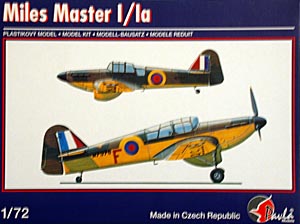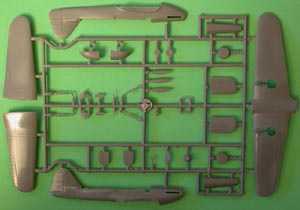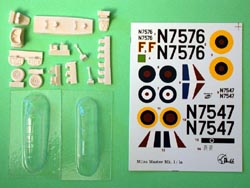Pavlaís 1/72 Miles Master I/Ia
|
 |
History
The Miles Master was a direct follow-on of the Miles Kestrel, a low-wing
high-speed trainer that was unique in the fact that it had a top speed
nearly as fast as that of the Hurricane and Spitfire.† This incredible
performance was only slightly degraded in the production version of the
Master I, fitted with a Kestrel Mk. XXX engine.† The great speed and excellent
maneuverability was in excess of any other trainer and prompted suggestions
for a fighter version.† The end of the Battle of Britain took the pressure
off of the fighter force and the necessity of the Miles Master fighter
wasnít as pressing, with the result that the fighter version wasnít produced.†
The trainer version did find widespread service, however, with just about
every operational squadron having at least one Master on strength.
The Kit
 To
date the number of Miles Master I kits are under five, with only the Pegasus
and Magna Models ones being available in any kind of quantities.† Pavlaís
latest release is probably the best Master I kit on the market now, with
a combination of injection plastic and resin detail parts.† Two vacuformed
canopies are included, but one isnít a spare as there are two styles of
framing for the different versions.† A small decal sheet provides markings
for two Masters, one Mk. I and one Mk.
Ia.† The parts are crisply molded for
the most part, with recessed panel lines.† The inside faces of the plastic
parts have a rough texture to them, but a bit of light sanding will take
care of that. To
date the number of Miles Master I kits are under five, with only the Pegasus
and Magna Models ones being available in any kind of quantities.† Pavlaís
latest release is probably the best Master I kit on the market now, with
a combination of injection plastic and resin detail parts.† Two vacuformed
canopies are included, but one isnít a spare as there are two styles of
framing for the different versions.† A small decal sheet provides markings
for two Masters, one Mk. I and one Mk.
Ia.† The parts are crisply molded for
the most part, with recessed panel lines.† The inside faces of the plastic
parts have a rough texture to them, but a bit of light sanding will take
care of that.
Taking a look at the interior, the kit uses resin to good advantage
here, with the instrument panels, control sticks, sidewall detailing and
seats all being made up from this medium.† The seats have belts molded
in place, while the instrument panels have raised detailing with recesses
for the instrument faces.† The cockpit floor is plastic and has rudder
pedals molded in place.† Rounding out the insides is a rear bulkhead,
resulting in an interior that will look very good under that large clear
canopy.† Speaking of which, this is the first area requiring modification
depending on the version you want to model.† If youíre going to do a Master
Mk. Ia youíll need to trim part of the fuselage sides at the rear of the
cockpit.
Once the fuselage is together, construction is pretty straightforward.†
The main wing is split into a one-piece lower section and separate right
and left upper halves.† The landing light isnít cut out in the wing, but
the instructions point out what you need to do to make a proper light.†
The wheel wells are separate frying pan-shaped pieces that fit onto the
lower wing.† The horizontal tailplanes are molded right and left as one
piece.† No locating tabs are present so you might want to drill holes
and pin these parts in place.† An information view shows the arrangement
of the tailplanes & wing to the fuselage.
 The
undercarriage is fairly basic as would be expected on a trainer.† Thereís
the main strut, molded as one piece, with a separate bracing strut and
gear doors to add strength.† The main wheels are resin, while the tailwheel
assembly is all plastic with a separate strut and wheel.† The propeller
is made up from three blades and a two-part hub.† Nothing but dimples
are provided for locating the propeller blades so dig out your jig to
get things in alignment here. The
undercarriage is fairly basic as would be expected on a trainer.† Thereís
the main strut, molded as one piece, with a separate bracing strut and
gear doors to add strength.† The main wheels are resin, while the tailwheel
assembly is all plastic with a separate strut and wheel.† The propeller
is made up from three blades and a two-part hub.† Nothing but dimples
are provided for locating the propeller blades so dig out your jig to
get things in alignment here.
The decals offer a couple of options, both finished in dark green and
dark earth over trainer yellow.† The first choice is a Master Mk. I, N7576,
from No. 8 Flying Training
School.† Before Spring of 1940 it was attached
to the Station Flight on the Ternhill Air Base.† Coded red ĎFí, this plane
has an interesting fuselage roundel devoid of white but with a thick yellow
outline.† The second choice is N7547, one of the Master Mk. Ia aircraft
transferred to one of the Fleet Air Arm training units in February of
1940.† This plane also has a fuselage roundel devoid of white, but with
a thinner yellow outline.† Both aircraft feature an interesting swept
fin flash.† The decals are printed by MPD and are in excellent register.
Conclusion
If you want to build a Miles Master Mk. I this is the kit to get.† Itís
a fairly simple model with a basic paint scheme but its use of trainer
yellow will definitely make it stand out on your shelves.† Alternatively,
sticking one of these in the corner of your massive Hurricane Airfield
diorama would be just the thing to add that bit of visual flavor (and
if you are doing a massive Hurricane Airfield diorama, I want to hear
about it!).
|








|

 To
date the number of Miles Master I kits are under five, with only the Pegasus
and Magna Models ones being available in any kind of quantities.† Pavlaís
latest release is probably the best Master I kit on the market now, with
a combination of injection plastic and resin detail parts.† Two vacuformed
canopies are included, but one isnít a spare as there are two styles of
framing for the different versions.† A small decal sheet provides markings
for two Masters, one Mk. I and one
To
date the number of Miles Master I kits are under five, with only the Pegasus
and Magna Models ones being available in any kind of quantities.† Pavlaís
latest release is probably the best Master I kit on the market now, with
a combination of injection plastic and resin detail parts.† Two vacuformed
canopies are included, but one isnít a spare as there are two styles of
framing for the different versions.† A small decal sheet provides markings
for two Masters, one Mk. I and one  The
undercarriage is fairly basic as would be expected on a trainer.† Thereís
the main strut, molded as one piece, with a separate bracing strut and
gear doors to add strength.† The main wheels are resin, while the tailwheel
assembly is all plastic with a separate strut and wheel.† The propeller
is made up from three blades and a two-part hub.† Nothing but dimples
are provided for locating the propeller blades so dig out your jig to
get things in alignment here.
The
undercarriage is fairly basic as would be expected on a trainer.† Thereís
the main strut, molded as one piece, with a separate bracing strut and
gear doors to add strength.† The main wheels are resin, while the tailwheel
assembly is all plastic with a separate strut and wheel.† The propeller
is made up from three blades and a two-part hub.† Nothing but dimples
are provided for locating the propeller blades so dig out your jig to
get things in alignment here.





